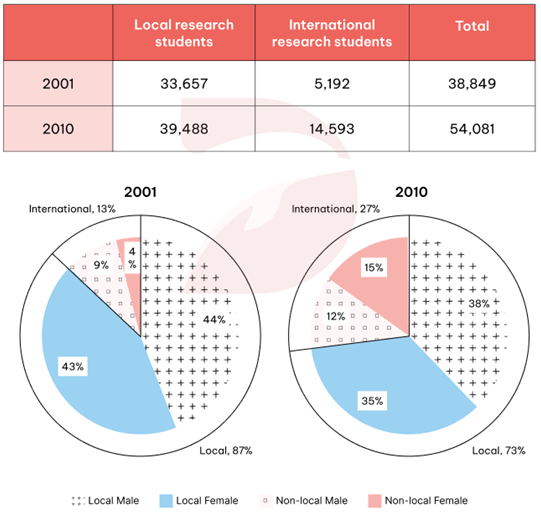5+ The table and pie charts below show the number of research students in Australian
The table and pie charts below show the number of research students in Australian universities in 2001 and 2010. Summarise the information by selecting and reporting the main features, and make comparisons where relevant. Write at least 150 words hay nhất giúp bạn có thêm tài liệu tham khảo để viết bài luận bằng Tiếng Anh hay hơn.
- The table and pie charts below show the number of research students in Australian (mẫu 1)
- The table and pie charts below show the number of research students in Australian (mẫu 2)
- The table and pie charts below show the number of research students in Australian (mẫu 3)
- The table and pie charts below show the number of research students in Australian (mẫu 4)
- The table and pie charts below show the number of research students in Australian (mẫu 5)
- The table and pie charts below show the number of research students in Australian (mẫu 6)
- The table and pie charts below show the number of research students in Australian (mẫu 7)
- The table and pie charts below show the number of research students in Australian (mẫu 8)
5+ The table and pie charts below show the number of research students in Australian
Đề bài: The table and pie charts below show the number of research students in Australian universities in 2001 and 2010. Summarise the information by selecting and reporting the main features, and make comparisons where relevant. Write at least 150 words
The table and pie charts below show the number of research students in Australian - mẫu 1
The provided charts illustrate the participation of local and international students in research fields at Australian universities in 2001 and 2010, along with a breakdown of research students by gender over the same period.
Overall, there was a notable increase in the number of students pursuing research between 2001 and 2010. What also stands out from the chart is that local students showed a particularly strong interest in research, outnumbering their international counterparts in both years. Additionally, local male students dominated the major in both periods.
In 2001, approximately 34,000 Australian students engaged in research, nearly seven times the figure for their international counterparts. For the following 10 years, the number of local students grew modestly to roughly 40,000 students. Even though a threefold increase to around 15000 international students was recorded in the participation in research majors, this figure was far lower than that of local students in 2010.
Turning to gender distribution, the proportion of male and female local students in research fields was relatively balanced in 2001, at 44% and 43% respectively. Among international students, however, there was a notable gender disparity, with only 9% male and 4% female. By 2010, the gender gap among local students had widened slightly, with males accounting for 38% compared to 35% of females. A similar gap of 3% could also be seen in the percentage of international students choosing research fields. However, among these students, the proportion of females, at 15%, surpassed that of males, standing at 13%, indicating a shifting trend over a decade.
The table and pie charts below show the number of research students in Australian - mẫu 2
The table illustrates how many local and foreign research students studied at universities in Australia in the years 2001 and 2010, while the pie charts show the proportions of gender among those same students.
Overall, there was an increase in the total number of research students in Australian universities, with local students far outnumbering their non-local counterparts in both years. Despite this, the former’s share decreased as international enrollments rose. Additionally, the gender distribution remained relatively balanced.
In 2001, Australian colleges had 33,657 domestic and 5,192 international students engaged in research, totaling 38,849. By 2010, local student numbers had risen slightly to 39,488, while that of international students had almost tripled to 14,593, bringing the total number to 54,081.
In terms of gender distribution, in 2001, local research students made up 87% of the total, with almost equal percentages across both sexes. Their international counterparts, split between 9% male and 4% female, accounted for the remaining 13%. By 2010, the proportion of domestic research students had declined to 73%, yet the gender gap widened slightly, with males and females representing 38% and 35% respectively. This fall corresponded with a two-fold rise in the percentage of foreign research students, reaching 27%, where females (15%) surpassed males (12%).
The table and pie charts below show the number of research students in Australian - mẫu 3
The table and pie graphs depict the number of domestic and foreign students involved in research, with a further breakdown of the proportion of genders, in Australian colleges in two separate years: 2001 and 2010. Overall, the total number of students increased, which was mirrored by both nationality categories. Additionally, local students consistently accounted for the larger share, and gender distribution was fairly even across all students throughout.
Regarding student counts, 2001 recorded 33,657 domestic students and 5,192 foreign ones, totaling 38,849. A decade later, local students increased to 39,488, whereas their international counterparts nearly tripled to 14,593 individuals. Accordingly, the total number of university research students in Australia rose to 54,081.
Concerning the composition, in 2001, local undergraduates accounted for 87% of the total number, with gender distribution being almost identical. Meanwhile, international male and female students constituted 4% and 9%, respectively, making up 13% of the total. By 2010, the percentage of local students dropped to 73%, which resulted from decreases in males to 38% and females to 35%. Finally, the increases in the rate of overseas males to 12% and females to 15% ultimately led to an overall 27% representation.
The table and pie charts below show the number of research students in Australian - mẫu 4
The table and pie chart illustrate data on the number of students doing research degrees in Australian universities in 2001 and 2010.
Overall, there was a strong growth in the total number of research students while significantly more local students enrolled in research courses compared to international students.
The number of local research students rose slightly from 33,577 to 39,488 during the 9-year period. Yet there was an almost threefold increase in that of international students, jumping from over 5,000 in 2001 to nearly 14,600 students in 2010. This resulted in an increase of around 15,000 in the total amount of research students in Australian universities, though by 2010, there still had been a huge difference of roughly 25,000 between the number of international and local students pursuing research programs.
In 2001, the proportion of international research students who were male, which accounted for 9% of the total, was more than double that of females (4%). However, 9 years later, the figures for female international students increased and overtook that of males, reaching 15% and 12% of the total respectively. By contrast, the percentages of male and female local research students stayed either equal or similar to each other in the two years surveyed.
The table and pie charts below show the number of research students in Australian - mẫu 5
The table and pie charts give information about how many research students studied at universities in Australia in the years 2001 and 2010.
Overall, the number of research students saw a significant rise over the period given, with local research students far exceeding international ones. It is also noticeable that the figures for males and females, regardless of local and international students, were relatively the same in both years, except for those for local males in 2001, which were almost twice as high as their female counterparts.
In 2001, Australian universities recorded a total of 38,849 research students, of which a striking 33,657 students came from Australia, whereas the rest (5,192) were from other countries. Over the following nine years, considerable growth was seen in the total number, increasing to 54,081. Notably, such a growth primarily resulted from international research students, whose numbers almost tripled to 14,593, compared to a marginal increase of around 6,000 among local research students, although they still clearly dominated the table.
Regarding local students doing research in Australian universities, the percentage of males and females made up a combined 87%, with each gender accounting for around 44%. However, in 2010, both of these proportions underwent a declining pattern, falling to 38% and 35% respectively. As for foreign research students, initially 9% of them were males, as opposed to only 4% of their female counterparts, after which their enrollment rates rose noticeably, with a more significant rise seen in the number of female international research students (15% in 2010).
The table and pie charts below show the number of research students in Australian - mẫu 6
The provided charts give information about the figures for local and international students going to Australian universities to participate in research fields in 2001 and 2010, along with a breakdown of research students by gender over the same period shown.
Overall, there was a significant increase in the number of both local and international research students between 2001 and 2010. It can also be seen that Australian students showed an intense interest in research, outnumbering their international counterparts; moreover, local males dominated the major in both years.
In 2001, the figure for Australian students specializing in research was approximately 34,000, which was tremendously higher than that of international students, with over 5,000. In the following 10 years, although the number of international research students saw a threefold increase to around 15,000 people, it was still far lower compared to the modest rise of local students, with about 40,000 people.
Looking at gender distribution, the percentage of male and female local students pursuing research was relatively balanced in 2001, at 44% and 43% respectively; however, the opposite was true for international students, with only 9% male and 4% female. 10 years later, there was a slightly wider gender gap among local students, with 38% male and 35% female. Likewise, a similar gap of 3% was witnessed in the proportion of international students choosing research fields. Nevertheless, a shifting trend could be seen when the proportion of females, at 15%, surpassed that of males, standing at 13% over ten years.
The table and pie charts below show the number of research students in Australian - mẫu 7
The table and the pie charts show the local and international research students in Australian universities between 2001 to 2010.
In general, the strength of local research students in Australian universities remained higher than the international research students in both the years and with time the strength of both local and international students increased in universities.
According to the table, the strength of local research students in 2001 was 33,657 whereas the strength of international research students was only 5,192. On the other hand, the strength of both international and local research students increased to 39,488 and 14,593 in 2010. Overall, by 2010, 15,232 research students took admission in colleges.
The given pie charts provide an estimate of local students and international research students. The ratio of local students was 87% and international students was 13% in 2001. Whereas this ratio changed by 2010 as the strength of international students increased to 27% and local students’ strength reduced to 73%. Moreover, the pie charts are further divided into male and female categories and provide information about the amount of local and international research students based on gender. The percentage of international research students increased from 9% male and 4% female to 12% male and 15% female respectively.
The table and pie charts below show the number of research students in Australian - mẫu 8
The given diagrams compare the quantity of research students in Australian universities in two years.
It is obvious that Australian universities experienced a significant growth in the number of research students, and this growth was mainly contributed by the rise of international ones.
In 2001, about 39,000 was the total number of research students, in which the figure for local students (about 34,000) was almost six times higher than that of foreign ones. Regarding local students, the percentages of males and females were the same, accounting for 43% of the total number of students; however, within the foreign group, the proportion of males was over twice as high as that of females.
In 2010, there were just over 54,000 research students, and the percentage of local students declined to 73% as a result of the twofold increase of international students. Among international groups, the most noticeable growth was seen in the proportion of females with a fourfold increase while the figure for males slightly went up to 12%. In contrast, both the percentages of local male and female research students dropped slightly to 39% and 35% respectively.
Xem thêm các bài luận Tiếng Anh hay khác:
Đã có app VietJack trên điện thoại, giải bài tập SGK, SBT Soạn văn, Văn mẫu, Thi online, Bài giảng....miễn phí. Tải ngay ứng dụng trên Android và iOS.
Theo dõi chúng tôi miễn phí trên mạng xã hội facebook và youtube:Nếu thấy hay, hãy động viên và chia sẻ nhé! Các bình luận không phù hợp với nội quy bình luận trang web sẽ bị cấm bình luận vĩnh viễn.
- Đề thi lớp 1 (các môn học)
- Đề thi lớp 2 (các môn học)
- Đề thi lớp 3 (các môn học)
- Đề thi lớp 4 (các môn học)
- Đề thi lớp 5 (các môn học)
- Đề thi lớp 6 (các môn học)
- Đề thi lớp 7 (các môn học)
- Đề thi lớp 8 (các môn học)
- Đề thi lớp 9 (các môn học)
- Đề thi lớp 10 (các môn học)
- Đề thi lớp 11 (các môn học)
- Đề thi lớp 12 (các môn học)
- Giáo án lớp 1 (các môn học)
- Giáo án lớp 2 (các môn học)
- Giáo án lớp 3 (các môn học)
- Giáo án lớp 4 (các môn học)
- Giáo án lớp 5 (các môn học)
- Giáo án lớp 6 (các môn học)
- Giáo án lớp 7 (các môn học)
- Giáo án lớp 8 (các môn học)
- Giáo án lớp 9 (các môn học)
- Giáo án lớp 10 (các môn học)
- Giáo án lớp 11 (các môn học)
- Giáo án lớp 12 (các môn học)






 Giải bài tập SGK & SBT
Giải bài tập SGK & SBT
 Tài liệu giáo viên
Tài liệu giáo viên
 Sách
Sách
 Khóa học
Khóa học
 Thi online
Thi online
 Hỏi đáp
Hỏi đáp

